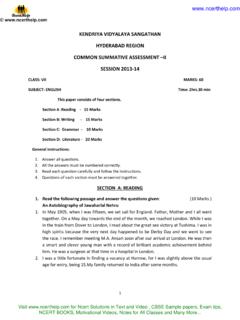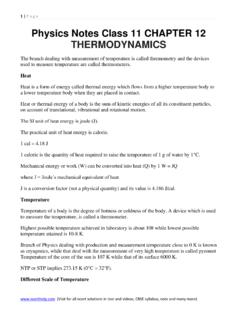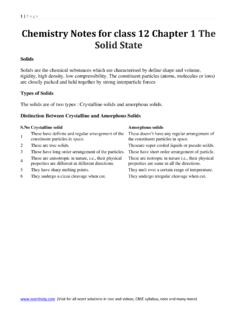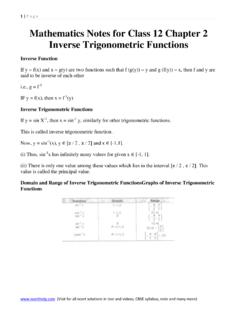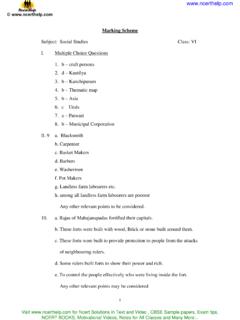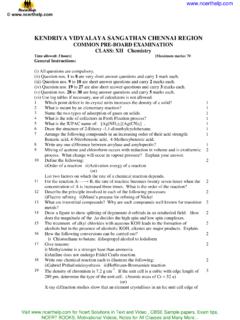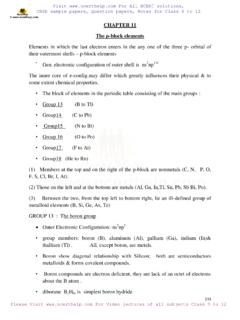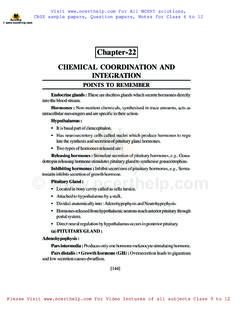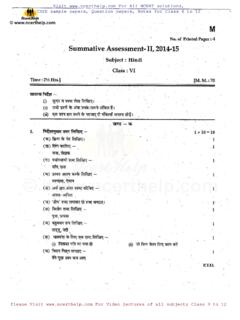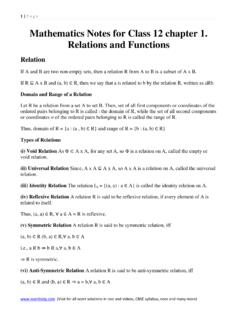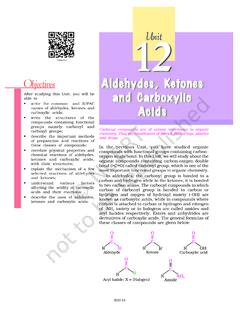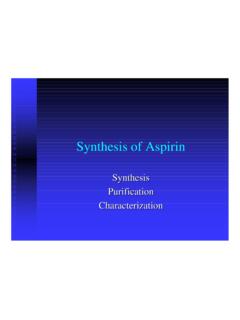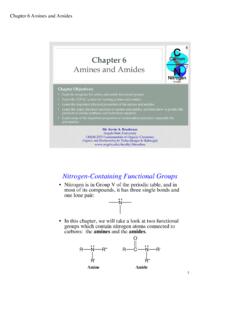Transcription of Chemistry Notes for class 12 Chapter 12 ... - NCERT help
1 1|Page Chemistry Notes for class 12 Chapter 12. Aldehydes, Ketones and carboxylic Acids In aldehydes, the carbonyl group ( )C=O) is bonded to carbon and hydrogen, while in the ketones, it is bonded to two carbon atoms Nature of Carbonyl Group The carbon and oxygen of the carbonyl group are Sp2 hybridised and the carbonyl double bond contains one o-bond and one -bond. The electronegativity of oxygen is much higher than that of the carbon, so there electron cloud is shifted towards the oxygen. Therefore, C-O bond is polar in nature. Nomenclature (i) Nomenclature of aldehydes In IUPAC system, the suffix e of alkane is replaced by the suffIX al . , (ii) Nomenclature of ketones In IUPAC system, the suffix e of alkane is replaced by one.
2 , Preparation of Aldehydes and Ketones (i) By oxidation of alcohols Aldehydes and ketones are generally prepared by oxidation of primary and secondary alcohols, respectively. (Visit for all NCERT solutions in text and videos, CBSE syllabus, note and many more). 2|Page (ii) By dehydrogenation of alcohols In this method, alcohol vapours are passed over heavy metal catalysts (Ag or Cu). Primary and secondary alcohols give aldehydes and ketones. (iii) By ozonolysis of alkenes (iv) By hydration of alkynes Acetylene on hydration gives acetaldehyde and other alkynes on hydration give ketones. (Visit for all NCERT solutions in text and videos, CBSE syllabus, note and many more).
3 3|Page Preparation of Aldehydes (Visit for all NCERT solutions in text and videos, CBSE syllabus, note and many more). 4|Page (Visit for all NCERT solutions in text and videos, CBSE syllabus, note and many more). 5|Page Preparation of Ketones (Visit for all NCERT solutions in text and videos, CBSE syllabus, note and many more). 6|Page Physical Properties of Aldehydes and Ketones 1. Methanal (HCHO) is a gas at room temperature. and its 40% aqueous solution is known as formalin. It is a reducing agent in silvering of mirrors and decolourising vat dyes. 2. Ethanal (CH3 CHO) is a volatile liquid. Other aldehydes and ketones are liquid or solid at room temperature.
4 3. The boiling point of aldehydes and ketones are higher than hydrocarbons and ethers of comparable molecular mass due to high magnitude of dipole-dipole interactions. 4. Aldehydes and ketones have lower boiling point than those of alcohols of similar molecular (Visit for all NCERT solutions in text and videos, CBSE syllabus, note and many more). 7|Page masses due to absence of intermolecular hydrogen bonding. 5. The lower members of aldehydes and ketones are miscible with water due to the formation of hydrogen bond with water. However, the solubility decreases with increase in length of alkyl chain. 6. Acetophenone is a hypnotic (sleep producing drug) so used as a medicine under the name hypnone.
5 Chemical Reactions of Aldehydes and Ketones (Visit for all NCERT solutions in text and videos, CBSE syllabus, note and many more). 8|Page (ii) Addition of ammonia and its derivatives Reaction with ammonia (Visit for all NCERT solutions in text and videos, CBSE syllabus, note and many more). 9|Page Some N-substituted derivatives of Aldehydes and Ketones (Visit for all NCERT solutions in text and videos, CBSE syllabus, note and many more). 10 | P a g e (iii) Reduction Aldehydes and ketones are reduced to primary and secondary alcohols respectively by sodium borohydride (NaBH4) or lithium aluminium hydride [LiAlH4]. (iv) Oxidation Aldehydes get easily oxidised to carboxylic acids by HNO3, KMnO4, K2Cr2O7, etc.
6 , or even by mild oxidising agent. (Visit for all NCERT solutions in text and videos, CBSE syllabus, note and many more). 11 | P a g e During oxidation of unsymmetrical ketones the point of cleavage is such that keto group stays preferentially with the smaller alkyl group popoff s rule). [Fehling solution is a mixture of Fehling solution A and Fehling solution B in 1: 1 ratio. Fehling solution A is aqueous copper sulphate and Fehling solution B is alkaline sodium potassium tartrate which is also called, Rochelle salt.]. (c) Benedict solution With it, aldehydes (except benzaldehyde) also give red ppt. of CU2O. (d) Schiff's reagent It is an aqueous solution of magenta or pink coloured rosaniline hydrochloride which has been decolourised by passing SO2, Aldehydes give pink colour with this reagent but ketones do not.
7 Haloform reaction Aldehydes and ketones having at east one methyl group [3- hydrogen]. linked to the carbonyl carbon atom (methyl ketones) are oxidised by sodium hypohalite to sodium salts of corresponding carboxylic acids having one carbon atom less than that of carbonyl compound. The methyl group is converted to haloform. (Visit for all NCERT solutions in text and videos, CBSE syllabus, note and many more). 12 | P a g e Iodoform reaction with sodium hypoiodite is also used for the detection of CH 3 group or CH3CH(OH)- group by producing yellow solid CHI3. (v) Aldol condensation Its further condensation gives phorone, This reaction is exhibited by those aldehydes and ketones which have at least one a-hydrogen.
8 (Visit for all NCERT solutions in text and videos, CBSE syllabus, note and many more). 13 | P a g e (vi) Cross aldol condensation Base catalysed crossed aldol condensation between an aromatic aldehyde and an aliphatic aldehyde or ketone is called Claisen-Schmidt condensation or Claisen reaction. The above reaction is called Benzoin condensation, not the cross aldol condensation. (Visit for all NCERT solutions in text and videos, CBSE syllabus, note and many more). 14 | P a g e (vii) Cannizzaro reaction Aldehydes which do not have any hydrogen atom, undergo self oxidation and reduction (disproportionation) reaction on treatment with concentrated alkali. (viii) Electrophilic substitution reaction Aromatic aldehydes and ketones undergo electrophilic substitution.
9 Carbonyl group shows + R effect, therefore acts as a deactivating and meta directing group. (ix) Baeyer- ViLLiger oxidation With Caro s acid (H2SO5) or per benzoic acid (C6H5CO3H). or peracetic acid (CH3CO3H) aliphatic ketones give ester. (xi) Knoevenagel reaction It involves condensation between active methylene group and ,carbonyl groups in the presence of base. (Visit for all NCERT solutions in text and videos, CBSE syllabus, note and many more). 15 | P a g e (Visit for all NCERT solutions in text and videos, CBSE syllabus, note and many more). 16 | P a g e carboxylic Acids Classification Depending upon the number of -COOH groups, they are classified as (i) monocarboxylic acids; containing one -COOH group (ii) dicarboxylic acids: containing two -COOH groups.
10 Sources of carboxylic acids (Visit for all NCERT solutions in text and videos, CBSE syllabus, note and many more). 17 | P a g e Nomenclature Their IUPAC names have been derived from the corresponding alkanes by replacing the letter li of the alkane with oic and adding suffix acid at the end, Thus, monocarboxylic acids are called alkanoic acids. Methods of Preparation of Monocarboxylic Acids (i) From primary alcohols and aldehydes (ii) From alkyl benzenes Alkyl benzene when treated with strong oxidising agent like H2 CrO4 (chromic acid), acidic or alkaline KMnO4 gives benzoic acid. (Visit for all NCERT solutions in text and videos, CBSE syllabus, note and many more).
